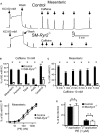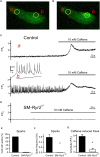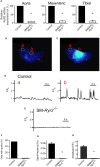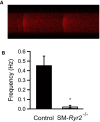Role of Ryanodine Type 2 Receptors in Elementary Ca2+ Signaling in Arteries and Vascular Adaptive Responses
- PMID: 31030596
- PMCID: PMC6512102
- DOI: 10.1161/JAHA.118.010090
Role of Ryanodine Type 2 Receptors in Elementary Ca2+ Signaling in Arteries and Vascular Adaptive Responses
Abstract
Background Hypertension is the major risk factor for cardiovascular disease, the most common cause of death worldwide. Resistance arteries are capable of adapting their diameter independently in response to pressure and flow-associated shear stress. Ryanodine receptors (RyRs) are major Ca2+-release channels in the sarcoplasmic reticulum membrane of myocytes that contribute to the regulation of contractility. Vascular smooth muscle cells exhibit 3 different RyR isoforms (RyR1, RyR2, and RyR3), but the impact of individual RyR isoforms on adaptive vascular responses is largely unknown. Herein, we generated tamoxifen-inducible smooth muscle cell-specific RyR2-deficient mice and tested the hypothesis that vascular smooth muscle cell RyR2s play a specific role in elementary Ca2+ signaling and adaptive vascular responses to vascular pressure and/or flow. Methods and Results Targeted deletion of the Ryr2 gene resulted in a complete loss of sarcoplasmic reticulum-mediated Ca2+-release events and associated Ca2+-activated, large-conductance K+ channel currents in peripheral arteries, leading to increased myogenic tone and systemic blood pressure. In the absence of RyR2, the pulmonary artery pressure response to sustained hypoxia was enhanced, but flow-dependent effects, including blood flow recovery in ischemic hind limbs, were unaffected. Conclusions Our results establish that RyR2-mediated Ca2+-release events in VSCM s specifically regulate myogenic tone (systemic circulation) and arterial adaptation in response to changes in pressure (hypoxic lung model), but not flow. They further suggest that vascular smooth muscle cell-expressed RyR2 deserves scrutiny as a therapeutic target for the treatment of vascular responses in hypertension and chronic vascular diseases.
Keywords: BKCa channel; Ca2+ sparks; blood pressure; hypoxia; isoforms; pulmonary hypertension; ryanodine receptors.
Figures












Similar articles
-
Nanoscale remodeling of ryanodine receptor cluster size underlies cerebral microvascular dysfunction in Duchenne muscular dystrophy.Proc Natl Acad Sci U S A. 2018 Oct 9;115(41):E9745-E9752. doi: 10.1073/pnas.1804593115. Epub 2018 Sep 4. Proc Natl Acad Sci U S A. 2018. PMID: 30181262 Free PMC article.
-
Regulation of calcium sparks and spontaneous transient outward currents by RyR3 in arterial vascular smooth muscle cells.Circ Res. 2001 Nov 23;89(11):1051-7. doi: 10.1161/hh2301.100250. Circ Res. 2001. PMID: 11717163
-
Negative regulation of cellular Ca2+ mobilization by ryanodine receptor type 3 in mouse mesenteric artery smooth muscle.Am J Physiol Cell Physiol. 2018 Jul 1;315(1):C1-C9. doi: 10.1152/ajpcell.00006.2018. Epub 2018 Mar 14. Am J Physiol Cell Physiol. 2018. PMID: 29537866
-
Elementary calcium signaling in arterial smooth muscle.Channels (Austin). 2019 Dec;13(1):505-519. doi: 10.1080/19336950.2019.1688910. Channels (Austin). 2019. PMID: 31797713 Free PMC article. Review.
-
Cross Talk Between Mitochondrial Reactive Oxygen Species and Sarcoplasmic Reticulum Calcium in Pulmonary Arterial Smooth Muscle Cells.Adv Exp Med Biol. 2017;967:289-298. doi: 10.1007/978-3-319-63245-2_17. Adv Exp Med Biol. 2017. PMID: 29047093 Review.
Cited by
-
Rieske iron-sulfur protein induces FKBP12.6/RyR2 complex remodeling and subsequent pulmonary hypertension through NF-κB/cyclin D1 pathway.Nat Commun. 2020 Jul 15;11(1):3527. doi: 10.1038/s41467-020-17314-1. Nat Commun. 2020. PMID: 32669538 Free PMC article.
-
MicroRNA-210 Mediates Hypoxic Pulmonary Hypertension in the Newborn Lamb.Hypertension. 2025 Jun;82(6):1151-1163. doi: 10.1161/HYPERTENSIONAHA.124.23061. Epub 2025 Apr 23. Hypertension. 2025. PMID: 40265266
-
Loss of anoctamin 1 reveals a subtle role for BK channels in lymphatic muscle action potentials.J Physiol. 2024 Jul;602(14):3351-3373. doi: 10.1113/JP285459. Epub 2024 May 5. J Physiol. 2024. PMID: 38704841 Free PMC article.
-
A computational model predicts sex-specific responses to calcium channel blockers in mammalian mesenteric vascular smooth muscle.Elife. 2024 Feb 9;12:RP90604. doi: 10.7554/eLife.90604. Elife. 2024. PMID: 38335126 Free PMC article.
-
Unexpected sirolimus-stimulated airway hyperreactivity in lymphangioleiomyomatosis.ERJ Open Res. 2023 Aug 14;9(4):00305-2023. doi: 10.1183/23120541.00305-2023. eCollection 2023 Jul. ERJ Open Res. 2023. PMID: 37589458 Free PMC article.
References
-
- Bevan JA, Garcia‐Roldan JL, Joyce EH. Resistance artery tone is influenced independently by pressure and by flow. Blood Vessels. 1990;27:202–207. - PubMed
-
- Nelson MT, Patlak JB, Worley JF, Standen NB. Calcium channels, potassium channels, and voltage dependence of arterial smooth muscle tone. Am J Physiol. 1990;259:C3–C18. - PubMed
-
- Wang SQ, Wei C, Zhao G, Brochet DX, Shen J, Song LS, Wang W, Yang D, Cheng H. Imaging microdomain Ca2+ in muscle cells. Circ Res. 2004;94:1011–1022. - PubMed
-
- Jaggar JH, Wellman GC, Heppner TJ, Porter VA, Perez GJ, Gollasch M, Kleppisch T, Rubart M, Stevenson AS, Lederer WJ, Knot HJ, Bonev AD, Nelson MT. Ca2+ channels, ryanodine receptors and Ca(2+)‐activated K+ channels: a functional unit for regulating arterial tone. Acta Physiol Scand. 1998;164:577–587. - PubMed
Publication types
MeSH terms
Substances
Grants and funding
LinkOut - more resources
Full Text Sources
Molecular Biology Databases
Miscellaneous

